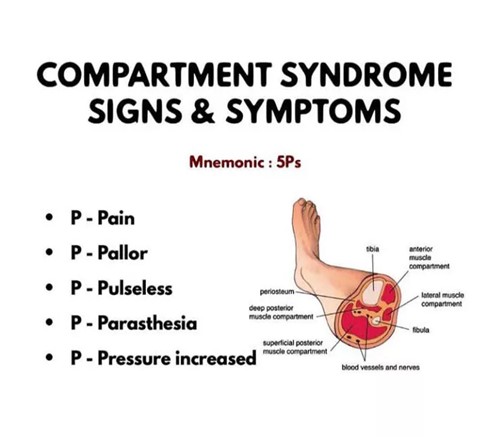A client is reporting pain in her casted leg. The nurse has administered analgesics and elevated the limb. Thirty minutes after administering the analgesics. the client states the pain is unrelieved. The nurse is unable to palpate the client's dorsalis pedis or posterior tibial pulse and the client's foot is pale. The nurse suspects compartment syndrome. What is the nurse's most appropriate action?
Promptly inform the primary provider.
Reassess the client's neurovascular status in 15 minutes.
Warm the client's foot and determine whether circulation improves.
Reposition the client with the affected foot dependent.
The Correct Answer is A
Explanation:
A. Promptly inform the primary provider:
Explanation: Compartment syndrome is a medical emergency that requires immediate intervention. If a nurse suspects compartment syndrome due to symptoms like severe unrelieved pain, absent pulses, and pale extremities, the most appropriate action is to promptly inform the primary healthcare provider. The provider can assess the situation, order necessary diagnostic tests, and potentially arrange for emergent interventions like fasciotomy to relieve compartment pressure.
B. Reassess the client's neurovascular status in 15 minutes:
Explanation: Waiting for 15 minutes to reassess the client's neurovascular status is not appropriate in this situation. Compartment syndrome can progress rapidly, leading to irreversible tissue damage within a short time frame. Delaying assessment and intervention can result in significant complications.
C. Warm the client's foot and determine whether circulation improves:
Explanation: Warming the foot is not appropriate in this context. Compartment syndrome is caused by increased pressure within the muscle compartment, leading to compromised circulation. Warming the foot will not address the underlying issue of elevated compartment pressure and can potentially worsen the condition by dilating blood vessels and increasing pressure further.
D. Reposition the client with the affected foot dependent:
Explanation: Repositioning the client with the affected foot dependent is contraindicated in compartment syndrome. Elevating the limb can worsen the condition by further restricting blood flow. The limb should be kept at or slightly below the level of the heart to maintain adequate perfusion until medical intervention can be initiated.

Nursing Test Bank
Naxlex Comprehensive Predictor Exams
Related Questions
Correct Answer is D
Explanation
A. Void every 6 to 8 hours:This interval may not be frequent enough. It is generally recommended to void every 2 to 3 hours to help flush out bacteria and reduce the risk of infection.
B. Avoid voiding immediately after sexual intercourse.This is not recommended. It is actually advised to void immediately after sexual intercourse to help flush out any bacteria that may have entered the urethra.
C. Take a bubble bath daily and keep the perineal region clean:
While keeping the perineal region clean is important for general hygiene, taking bubble baths and using heavily scented products can irritate the urethra and potentially increase the risk of UTIs. The nurse should advise against frequent bubble baths and suggest using mild, unscented soaps for the perineal area.
D. Increase the daily amount of water consumed:
Drinking more water helps increase urine output, which helps flush out bacteria from the urinary tract and can reduce the risk of recurrent UTIs.
Correct Answer is ["165"]
Explanation
To calculate the low range of the dosage, we need to use the lower end of the dosage range provided (1.5 mg/kg) and the client's weight in kilograms.
1 lb is approximately equal to 0.45 kg. So, to convert the client's weight from pounds to kilograms:
245 lbs * 0.45 kg/lb = 110.25 kg
Now, to calculate the low range dosage:
Low range dosage = 1.5 mg/kg * 110.25 kg = 165.375 mg
Rounding to the nearest whole number, the nurse should administer 165 mg for the low range of the dosage.
Whether you are a student looking to ace your exams or a practicing nurse seeking to enhance your expertise , our nursing education contents will empower you with the confidence and competence to make a difference in the lives of patients and become a respected leader in the healthcare field.
Visit Naxlex, invest in your future and unlock endless possibilities with our unparalleled nursing education contents today
Report Wrong Answer on the Current Question
Do you disagree with the answer? If yes, what is your expected answer? Explain.
Kindly be descriptive with the issue you are facing.
